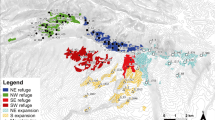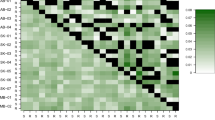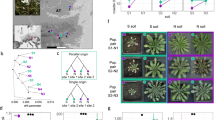Abstract
Three pairs of adjacent populations of Arrhenatherum elatius were studied both for their genetic diversity and for their genotypic structure. Each pair consisted of one population on a normal soil type and the other on spoil from mining.
Using morphological characters as well as allozyme markers, the genetic diversity in populations on toxic soils (mining spoil) was found to be higher than in populations in normal pasture. This suggests that the tolerant populations have been built up from a large number of tolerant genotypes emanating from normal pasture populations in which tolerance genes are not uncommon. The higher genetic diversity of the tolerant population has then been maintained by the spatial heterogeneity of toxic habitats, or less intense selective forces of biotic origin (e.g. intraspecific competition) or by a more open breeding system.
Variations in allozymes gave interesting clues. No clear cut differences in the genetic structure between pairs of populations were found, but there was a higher heterozygote deficit in denser populations.
This might arise from inbreeding because of a more limited gene flow in dense populations. The higher genetic diversity of sparse populations on toxic soil might partly result from the effectively greater gene flow into these populations in which individuals must trap pollen from longer distances than do individuals in dense populations.
Similar content being viewed by others
Article PDF
References
Antonovics, J. 1968. Evolution in closely adjacent plant population. V. Evolution of self fertility. Heredity, 23, 219–238.
Cahalan, C M, and Gliddon, C. 1985. Genetic neighbourhood in Primula vulgaris. Heredity, 54 (1), 65–70.
Cuguen, J, Acheroy, M, Loutfi, A, Petit, D, and Vernet, P H. 1989. Breeding system differentiation in Arrhenatherum elatius populations: evolution toward selfing? Evol Trends in Plants, 3, 17–24.
Ducousso, A. 1985. Comparaison de Populations Adjacentes d'Arrhenatherum elatius sur des Sols Normaux et Toxiques: Analyse de la Diversité Génétique et du Régime de Ia Reproduction. Thesis, University of Lille.
Ducousso, A, Loutfi, A, Petit, D, Acheroy, M, Valero, M, and Vernet, P H. 1987. Structure génétique et régime de la reproduction chez Arrhenatherum elatius L., Coll Nat CNRS “Biologie des Populations”, Lyon, 4–7 Sept. 1986, pp. 317–319.
Ellstrand, N C, Torres, A M, and Levin, D A. 1978. Density and the rate of apparent outcrossing in Helianthus annuus (Asteraceae). Syst Bot, 3, 403–407.
Gartside, D W, and McNeilly, T. 1974. The potential for evolution of heavy metal tolerance in plants. II. Copper tolerance in normal populations of different plant species. Heredity, 3, 335–348.
Gouyon, P H, Lumaret, R, Valdeyron, G, and Vernet, P H. 1983. Reproductive strategies and disturbance by Man, in Mooney, H. A. and Godron, M. (eds) Disturbance and Ecosystems Component of response Ecological Studies 44, Springer-Verlag, pp. 214–225.
Hedrick, P W, Ginevan, M E, and Ewing, E P. 1976. Genetic polymorphism in heterogeneous environments. Ann Rev Ecol Syst, 7, 1–32.
Hutcheson, K. 1970. A test for comparing diversities based en the Shannon formula. J theor Biol, 29, 151–154.
Lefebvre, C. 1970. Self-fertility in maritime and zinc mine populations of Armeria maritima (Mill.) Willd. Evolution, 24, 571–577.
Lefebvre, C, and Kakes, P. 1978. Variation electrophorétique des estérases des feuilles d'Armeria maritima (Mill.) Willd: quelques aspects taxonomiques etévolutifs. Bull Soc Roy Bot Belg, 114, 31–40.
Loutfi, A. 1987. Variabilitédu Régime de la Reproduction au Sein des Populations d'Arrhenatherum elatius de Milieux Contrastés. Thesis, University of Lille.
Lumaret, R. 1981. Structure génétique d'un complexe polyplolde Dactylis glomerata L. Thesis, U.S.T.L. Montpellier, 168p.
McNeilly, T, and Antonovics, J. 1968. Evolution in closely adjacent plant populations. IV. Barriers to gene flow. Heredity, 40, 371–384.
Pfitzenmeyer, C D. 1962. Biological flora of the British Isles: Arrhenatherum Elatius (L.) J. et C. Presl. J Ecol, 50, 235–245.
Shannon, C E, and Weaver, W. 1963. The Mathematical Theory of Communication. Urbana Univ. Illinois Press.
Sokal, R R, and Rohlf, F J. 1981. Biometry: The Principles and Practice of Statistics in Biological Research. Second edn. W. H. Freeman, New York, USA.
Soule, M E, and Simberloff, D. 1986. What do genetics and ecology tell us about design of nature reserves? Biolog Cons, 35, 19–40.
Sulinowski, S. 1965. Variation of forms and biology of flowering in Arrhenatherum elatius (L.) PB. Part II. Effects of self and cross pollination on seed setting in Arrhenatherum elatius. Genetica Polonica, 6, 105–118.
Verkleij, J A C, Bast-Cramer, W B, and Levering, H. 1985. Effect of heavy metal stress on the genetic structure of populations of Silene cucubalus. In Haeck, J. and Woldendorp, J. W. (eds) Structure and Fonctionning of Plant Populations, vol. 2, North-Holland Publishing Company, Amsterdam, pp. 355–365.
Wahlund, S. 1928. Zuzammenzung von populationen und korelationscheinungen vom standpunkt der vererbungslehere aus betrachtet. Hereditas, 11, 65–106.
Wright, S. 1969. Theory of Gene Frequencies. University of Chicago Press, Chicago, vol. 2.
Wu, L, Bradshaw, A D, and Thurman, D A. 1975. The potential for evolution of heavy metal tolerance in plants. III. The rapid evolution of copper tolerance in Agrostis stolonifera. Heredity, 34, 165–185.
Author information
Authors and Affiliations
Rights and permissions
About this article
Cite this article
Ducousso, A., Petit, D., Valero, M. et al. Genetic variation between and within populations of a perennial grass: Arrhenatherum elatius. Heredity 65, 179–188 (1990). https://doi.org/10.1038/hdy.1990.86
Received:
Issue date:
DOI: https://doi.org/10.1038/hdy.1990.86
This article is cited by
-
Low genetic differentiation despite high fragmentation in the endemic serpentinophyte Minuartia smejkalii (M. verna agg., Caryophyllaceae) revealed by RADSeq SNP markers
Conservation Genetics (2020)
-
Genetic diversity and association mapping of cadmium tolerance in bermudagrass [Cynodon dactylon (L.) Pers.]
Plant and Soil (2015)
-
Genetic Variation in Three Closely Related Minuartia (Caryophyllaceae) Species Endemic to Greece: Implications for Conservation Management
Folia Geobotanica (2014)
-
Vulnerability of wild American ginseng to an extreme early spring temperature fluctuation
Population Ecology (2011)
-
Chloroplast microsatellites reveal that metallicolous populations of the Mediterranean shrub Cistus ladanifer L have multiple origins
Plant and Soil (2010)



